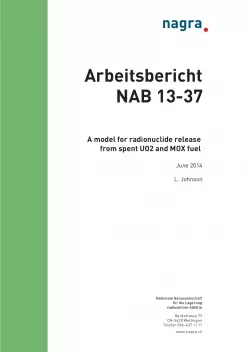
Arbeitsbericht NAB 13-37
A model for radionuclide release from spent UO2 and MOX fuel
The objective of the present report is to provide a model for release of radionuclides from spent fuel for performance assessment calculations as part of SGT Stage 2, including the definition and justification of parameter values for the model.
Discussion of the detailed mechanistic basis of the model is limited, as several recent comprehensive discussions of the relevant processes are available. In the case of processes responsible for rapid release of radionuclides, the discussions in SKB (2010a,b) and Johnson et al. (2012) provide most of the background. For the dissolution rate of the oxide matrix and associated radionuclide release, the detailed reviews of Shoesmith (2008), Curti (2011), SKB (2010a,b) and Ollila (2011) are available.
Figure 1 shows the conceptual distribution in a spent fuel rod of radionuclides relevant to long-term safety assessment. During in-reactor irradiation, a fraction of the inventory of some radionuclides produced in the UO2 is segregated to grain boundaries, to cracks in the fuel and to the gap between the fuel and cladding. Similarly, a fraction of the fission gas produced also segregates. The majority of the radionuclide inventory resides in the UO2 matrix and in the cladding.
